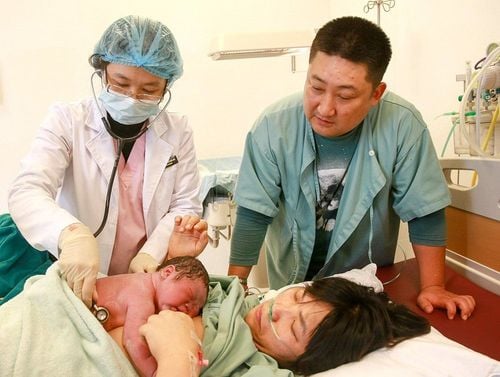This is an automatically translated article.
The article was professionally consulted by Specialist Doctor I Nguyen Thi My Linh - Neonatologist - Department of Pediatrics - Neonatology - Vinmec Danang International General Hospital.While in the womb, the fetus eats from the umbilical cord, receives nutrients through the umbilical cord, not from the stomach. That's why your baby's stomach is very small at birth and will increase in size in the following days.
1. What is the stomach size in babies?
Days 1-2: The baby's stomach has not yet expanded well and is smaller than a pea, so it can only hold about 5-7ml of milk/time on the first day. This amount is equivalent to the amount of precious colostrum secreted by the new mother. Therefore, it is completely wrong for the mother to "initiate" the baby with up to 30ml of formula milk per meal and has a great influence on the baby.3 - 6 days after birth: The size of a newborn's stomach is as big as a grape and can hold about 30-60ml of milk/time of feeding.
1 month old baby : The size of a newborn's stomach is about the size of a chicken egg and can hold 80-150ml/time.
Children from 6 months to 1 year old: A child's stomach is equivalent to a small grapefruit and 5 times smaller than an adult's. At this time, the baby's stomach can hold about 200-250ml of milk (equivalent to 1 cup of rice).
2. Children's food needs through each stage

In addition, although the stomach size of children is 5 times smaller than that of adults, in terms of nutrition, children's needs are 3-5 times higher than that of adults. Accordingly:
A newborn baby will eat about 8 – 12 times within 24 hours in the first day. That is, about every 1-3 hours the baby eats once. As for babies who are at the age of weaning, they should be divided into 2-3 meals a day.
Trắc nghiệm: Thế nào là trẻ sơ sinh đủ tháng?
Đặc điểm bên ngoài của trẻ sơ sinh đủ tháng được thể hiện qua các tiêu chuẩn như: Cân nặng, chiều dài và hình thể. Theo dõi bài trắc nghiệm dưới đây sẽ giúp các bậc cha mẹ hiểu thế nào là trẻ sơ sinh đủ tháng, qua đó có thể đánh giá tổng trạng sức khỏe và sự phát triển của bé yêu nhà mình.The following content is prepared under supervision of Thạc sĩ, Bác sĩ y khoa, Ma Văn Thấm , Nhi , Phòng khám Đa khoa Quốc tế Vinmec Dương Đông(Phú Quốc)
3. Gastroesophageal reflux in infants
Gastroesophageal reflux disease occurs in two-thirds of children during the first years of life. Most reflux in children will go away after 12-14 months. However, there are also some children whose reflux lasts longer. Reflux is classified into two categories: physiological and pathological.Gastroesophageal reflux in infants is a phenomenon where the food. The gastric juices in the baby's stomach are pushed back up into the esophagus. Then push up the throat and spit out. This phenomenon is also known as basic reflux. It can appear in children at any time of the day or night. At this time, babies mainly eat milk, so they will only vomit milk.
When having acid reflux, babies will be very fussy, stop feeding. Difficulty sleeping at night, sometimes having to carry it all the time. In the long run, children will be prone to malnutrition and stunting.
If your baby is under 6 months old, spits up a few times a day but is still happy, gains weight well, doesn't have recurrent wheezing....then most likely it's just physiological reflux. If children still often spit milk after 1 year old, slow to gain weight, thin, afraid to eat, wheeze, recurrent pneumonia....then it is likely that reflux has become pathological.
How to take care of children with gastroesophageal reflux disease :
For babies who have not eaten solids (children under 4-6 months old): Parents feed the baby many times, the appropriate time to breastfeed is 2 hours later. previous feeding. After feeding, have the baby stand for 10-20 minutes. It is important to note that the baby should suckle in the correct position, latch on the right owl to limit the baby swallowing air. For babies who often use bottles, parents check to see if the size of the milk is suitable for the baby or not.

Finally, when putting the baby to sleep, parents put the baby's head slightly higher than the body. This will prevent gastroesophageal reflux in young children.
Specialist Doctor I Nguyen Thi My Linh has 12 years of experience in diagnosing and treating pediatric diseases, especially neonatal resuscitation and neonatal treatment. In addition, the doctor has strengths in the field of breastfeeding counseling as well as examination, counseling and nutritional intervention in children.
| Đăng ký tư vấn dinh dưỡng cho bé tại: https://i.vinmec.com/dangkytuvandinhduong |
|---|















